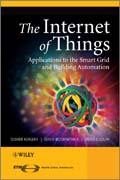
The internet of things: key applications and protocols
Hersent, Olivier
Boswarthick, David
Elloumi, Omar
An all-in-one reference to the major Home Area Networking, Building Automation and AMI protocols, including 802.15.4 over radio or PLC, 6LowPAN/RPL, ZigBee1.0 and Smart Energy 2.0, Zwave, LON, BACNet, KNX, ModBus, mBus, C.12 and DLMS/COSEM, and the new ETSI M2M system level standard. In-depth coverage of Smart-grid and EV charging use cases. This book describes the Home Area Networking, Building Automation and AMI protocols and their evolution towards open protocols based on IP such as 6LowPAN and ETSI M2M. The authors discuss the approach taken by service providers to interconnect the protocols and solve the challenge of massive scalability of machine-to-machine communication for mission-critical applications, based on the next generation machine-to-machine ETSI M2M architecture. The authors demonstrate, using the example of the smartgrid use case, how the next generation utilities, by interconnecting and activating ourphysical environment, will be able to deliver more energy (notably for electric vehicles) with less impact on our natural resources. Key Features: Offers acomprehensive overview of major existing M2M and AMI protocols Covers the system aspects of large scale M2M and smart grid applications Focuses on system level architecture, interworking, and nationwide use cases Explores recent emerging technologies: 6LowPAN, ZigBee SE 2.0 and ETSI M2M, and for existing technologies covers recent developments related to interworking Relates ZigBee to the issue of smartgrid, in the more general context of carrier grade M2M applications Illustrates the benefits of the smartgrid concept based on real examples, including business cases This book will be a valuable guide for project managers working on smartgrid, M2M, telecommunications and utility projects, system engineers and developers, networking companies, and home automation companies. It will also be of use to senior academic researchers, students, and policy makers and regulators. INDICE: List of Acronyms Introduction Part I M2M AREA NETWORK PHYSICAL LAYERS 1 IEEE 802.15.4 1.1 The IEEE 802 Committee Family of Protocols 1.2 The Physical Layer 1.2.1 Interferences with Other Technologies 1.2.2 Choice of a 802.15.4 Communication Channel, Energy Detection, Link Quality Information 1.2.3 Sending a Data Frame 1.3 The Media-Access Control Layer 1.3.1 802.15.4 Reduced Function and Full Function Devices, Coordinators, and the PAN Coordinator 1.3.2 Association 1.3.3 802.15.4 Addresses 1.3.4 802.15.4 Frame Format 1.3.5 Security 1.4 Uses of 802.15.4 1.5 The Future of 802.15.4: 802.15.4e and 802.15.4g 1.5.1 802.15.4e 1.5.2 802.15.4g 2 Powerline Communication for M2M Applications 2.1 Overview of PLC Technologies 2.2 PLC Landscape 2.2.1 The Historical Period(19502000) 2.2.2 After Year 2000: The Maturity of PLC 2.3 Powerline Communication: A Constrained Media 2.3.1 Powerline is a Difficult Channel 2.3.2 Regulation Limitations 2.3.3 Power Consumption 2.3.4 Lossy Network 2.3.5 Powerline isa Shared Media and Coexistence is not an Optional Feature 2.4 The Ideal PLC System for M2M 2.4.1 Openness and Availability 2.4.2 Range 2.4.3 Power Consumption 2.4.4 Data Rate 2.4.5 Robustness 2.4.6 EMC Regulatory Compliance 2.4.7 Coexistence 2.4.8 Security 2.4.9 Latency 2.4.10 Interoperability with M2M Wireless Services 2.5 Conclusion References Part II LEGACY M2M PROTOCOLS FOR SENSOR NETWORKS, BUILDING AUTOMATION AND HOME AUTOMATION 3 The BACnet Protocol 3.1 Standardization 3.1.1 United States 3.1.2 Europe 3.1.3 Interworking 3.2 Technology 3.2.1 Physical Layer 3.2.2 Link Layer 3.2.3 Network Layer 3.2.4 Transport and Session Layers 3.2.5 Presentation and Application Layers 3.3 BACnet Security3.4 BACnet Over Web Services (Annex N, Annex H6) 3.4.1 The Generic WS Model 3.4.2 BACnet/WS Services 3.4.3 The Web Services Profile for BACnet Objects 3.4.4 Future Improvements 4 The LonWorksControl Networking Platform 4.1 Standardization 4.1.1 United States of America 4.1.2 Europe 4.1.3 China 4.2 Technology 4.2.1 Physical Layer 4.2.2 Link Layer 4.2.3 Network Layer 4.2.4 Transport Layer4.2.5 Session Layer 4.2.6 Presentation Layer 4.2.7 Application Layer 4.3 Web Services Interface for LonWorks Networks: Echelon SmartServer 4.4 A REST Interface for LonWorks 4.4.1 LonBridge REST Transactions 4.4.2 Requests 4.4.3 Responses 4.4.4 LonBridge REST Resources 5 ModBus 5.1 Introduction 5.2 ModBus Standardization 5.3 ModBus Message Framing and Transmission Modes 5.4 ModBus/TCP 6KNX 6.1 The Konnex/KNX Association 6.2 Standardization 6.3 KNX Technology Overview 6.3.1 Physical Layer 6.3.2 Data Link and Routing Layers, Addressing 6.3.3 Transport Layer 6.3.4 Application Layer 6.3.5 KNX Devices, Functional Blocksand Interworking 6.4 Device Configuration 7 ZigBee 7.1 Development of the Standard 7.2 ZigBee Architecture 7.2.1 ZigBee and 802.15.4 7.2.2 ZigBee ProtocolLayers 7.2.3 ZigBee Node Types 7.3 Association 7.3.1 Forming a Network 7.3.2 Joining a Parent Node in a Network Using 802.
- ISBN: 978-1-119-99435-0
- Editorial: John Wiley & Sons
- Encuadernacion: Cartoné
- Páginas: 376
- Fecha Publicación: 06/01/2012
- Nº Volúmenes: 1
- Idioma: Inglés
